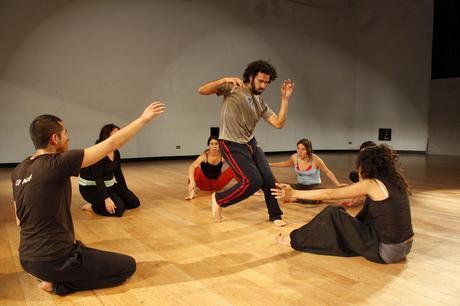
DESCRIPCIÓN DEL CURSO Este trabajo acerca a los no-hispano parlantes a una práctica y profundización del castellano a través del teatro.
La experiencia de la palabra en acción fomenta la espontaneidad en el manejo del lenguaje, en tanto que la improvisación exige una respuesta inmediata al problema planteado. La mejor manera de vivir la experiencia física del idioma es conocerlo poniendo el cuerpo en una situación determinada.
OBJETIVOS DEL CURSO Entrenar las destrezas comunicativas y aumentar las competencias lingüísticas a través del teatro para alcanzar un nivel superior en el dominio de la lengua española.
CONTENIDOS
MÓDULO 1. EXPRESIÓN
1.‑ IMPROVISACIÓN Y CALDEAMIENTO. Ejercicios de desinhibición y juego dramático, expresión corporal.
2.‑ APRENDER A MIRAR. La mirada en escena, detenerse en los detalles, poder mirar en conjunto todos los elementos que están interviniendo.
3.‑ APRENDER A ESCUCHAR. Elemento fundamental para la escena, saber escuchar a tu compañero y el resto de elementos escénicos. Responder orgánicamente a los impulsos que recibes.
4.‑ APRENDER A LEER . Expresión oral, dicción, fonética. Trabajo con textos escritos de diferentes géneros literarios.
5.‑ APRENDER A NARRAR. La figura del narrador de cuentos, y los tipos de discurso: político, publicitario, expositivo, argumentativo, persuasivo, informativo, conmemorativo y literario.
MÓDULO 2. DRAMATIZACIÓN
1.‑ LOS PERSONAJES. Trabajo con los roles, con el sí mágico escénico, con la posibilidades del disfraz.
2.‑ LAS SITUACIONES. Trabajo con escenas dramáticas sencillas. El rol del protagonista y antagonista.
3.‑ LOS CONFLICTOS. Trabajo de improvisación.
4.- EL CUERPO Y EL ESPACIO. El intérprete en relación con el espacio y sus elementos: luz, sonido, volúmenes, objetos, vestuario…
MÓDULO 3. TRABAJO CON ESCENAS Y MUESTRAS A PÚBLICO. Preparación de escenas breves para trabajar la memorización de texto y acciones y el compromiso de mostrarlo a un público determinado.
DESTINATARIOS Personas que estudian español como lengua extranjera y que quieren profundizar en sus conocimientos de la lengua española de una forma divertida, cooperativa y dinámica: a través del teatro.
DURACIÓN Curso de 48h de Enero a Junio de 1014.
HORARIOS Jueves ó Viernes de 7-9pm.
NÚMERO DE PARTICIPANTES Mínimo 4 alumnos, máximo 12.
Para más información podéis contactar con Cecilia Valencia a través de su correo electrónico: [email protected] o su teléfono: 699 780 145
SPEECH AND DRAMA IN SPANISH
DESCRIPTION OF THE COURSE This course leads to a practice and deepening of the Spanish language through theatre. The experience of the word in action promotes spontaneity in the use of the language, as improvisation requires an immediate response to the problem that has been set. The best way to live the physical experience of the language is to place the body in a specific situation.
OBJECTIVES OF THE COURSE Train communication skills and increase the linguistic competencies through theatre in order to reach a higher level in the use of the Spanish language.
CONTENTS
MODULE 1. EXPRESSION
1.‑ IMPROVISATION AND WARM UP. Disinhibition exercises. Dramatic Game. Body expression.
2.‑ LEARN HOW TO LOOK. The look on stage. To dwell on the details. To be able to look at the elements that are intervening as a whole.
3.‑ LEARN HOW TO LISTEN. Important element in the scene, to know how to listen to your colleague and to the rest of scenic elements in order to have an organic response to them.
4.‑ LEARN HOW TO READ. We will work on oral expression, diction and phonetics. We will use written texts of different genres.
5.‑ LEARN HOW TO NARRATE. We will work the storyteller role, and the different types of speeches: political, advertising, expository, argumentative, persuasive, informative, commemorative and literary.
MODULE 2. DRAMATIZATION
1.‑ THE CHARACTERS. Role playing games. Working with the scenical “if magical”. The possibilities of the costume.
2.‑ THE SITUATIONS. Working with simple dramatic scenes. The roles of the leading role and the antagonist.
3.‑ THE CONFLICTS. The essence of every scene, improvisation work.
4.‑ THE BODY AND THE STAGE SPACE. The performer in relation to the space and its elements: light, sound, volume, objects, clothing …
MODULE 3. WORKING WITH SCENES AND SHOWING IT TO AN AUDIENCE
The preparation of short scenes to work on the text and action memorization. Work on the commitment to show it to a concrete audience.
TARGET People who study the Spanish Language as a second language and who want to study in depth their knowledge of the Spanish Language in a fun, cooperative and dynamic way: through theatre.
WHEN 48H course from January to June 2014. Thursdays or Fridays from 7-9pm.
NUMBER OF PARTICIPANTS Min. 4, max. 12.
Information: contact with Cecilia Valencia c[email protected] Phone: 699 780 145
